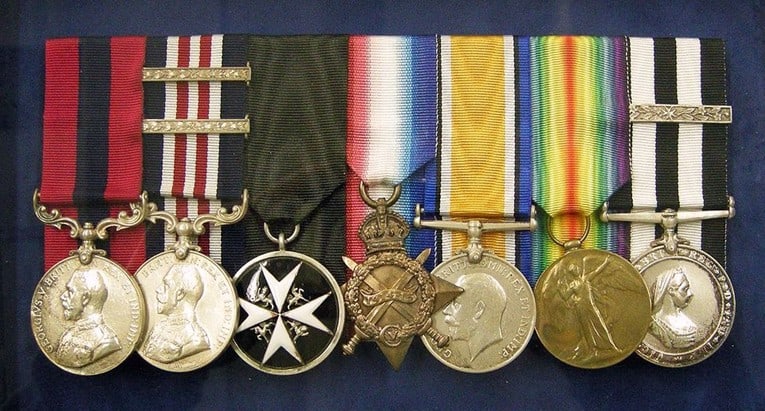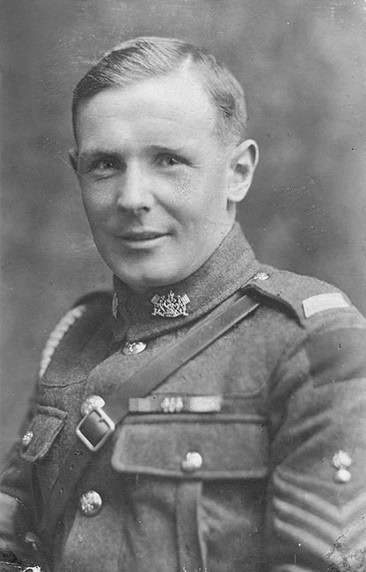Local Hero Sergeant George Oliver
The RCA Museum has proudly displayed Sergeant George J. Oliver’s military decorations since August 2006. Sergeant Oliver, a local hero from Brandon, received four decorations for bravery during the First World War. George was one of only five Canadians who won the Distinguished Conduct Medal and Military Medal with two bars for bravery.
On August 26, 2006, Isabel Shaw, the daughter of Sergeant George Oliver, presented her father’s medals to Rick Sanderson, the RCA Museum Director, for temporary display. Mrs. Shaw wanted them displayed at the museum ‘because they were too valuable to have at my home.’ She said, ‘It makes me feel very proud’ that her father’s medals for bravery are on display. Mark George, Regimental Major at the time, shared this sentiment, wanting the medals immediately on display to showcase the exploits of a local hero.
During WWI, seventy Canadians received the Victoria Cross, the highest award for valour. However, only five received the Distinguished Conduct Medal and Military Medal with two bars, making Sergeant Oliver’s achievement exceptionally rare.

Decorations of Sergeant George Oliver, from the left: DCM, MM with two bars, the Order of St. Johns of Jerusalem, 1914-18 Star, British War Medal, Victory Medal, and the Order of St. John Service Medal.

Sergeant George Oliver, 1919.
Born on February 23, 1892, George J. Oliver moved to Canada in 1907 and lived in Brandon and the Westman area for seven years. Since George was eighteen, he worked for his uncle as a pump technician in Forrest, Manitoba. When the war broke out, he enlisted in the 12th Manitoba Dragoons, trained at the Brandon Armoury, and joined the First Canadian Contingent at Camp Valcartier in Quebec.
While in Valcartier, Private Oliver joined the 5th Canadian Infantry Battalion on September 23, 1914. The Battalion departed with the First Contingent on October 3, sailing to England and arriving in Plymouth on October 15. After further training in England, they sailed to France as part of the 1st Canadian Division, reaching St. Nazaire on February 15, 1915, ready to make a difference.
Private Oliver served as an Infantryman in the 5th Battalion with the 2nd Brigade, where he faced German gas attacks during the Second Battle of Ypres. On June 1, 1915, he became a Signaller with the 2nd Canadian Infantry Brigade. Later, on December 21, 1915, the Canadian Army transferred him to the 1st Canadian Division Signal Company. The Signal Service was a crucial part of the Canadian Engineers, consisting of committed members known as linesmen or Sappers. Enemy artillery and gunfire disrupted communication lines, and technicians such as Sergeant Oliver had to enter the battlefield to fix them. He excelled at this task and earned four medals for bravery during critical battles.
George Oliver served at the Somme in 1916 and received his first Military Medal for bravery during the Battle of Vimy Ridge in 1917. His second and third decorations for gallantry came from Hill 70 and then Passchendaele in 1917. He received his fourth valour decoration, the Distinguished Conduct Medal, during the battle of Amiens, the first strong offensive of the Last Hundred Days in 1918. His war experiences were extensive, mirroring the experiences of the Canadian Army.
The Battle of Vimy Ridge began at daybreak on April 9, 1917. Signaler Oliver worked for 48 hours continually, risking his life to repair communications lines on Vimy Ridge, which were vital for the operation’s success. George’s courage and disregard for danger on the battlefield earned him the Military Medal, leading to a promotion to Acting Corporal on June 5, 1917.
On August 15, 1917, the 1st Canadian Division launched a bold assault on Hill 70. Acting Corporal Oliver maintained critical communications under heavy enemy artillery fire even after being buried three times. Oliver’s conspicuous gallantry earned him the First Bar to the Military Medal. In a heartwarming turn of events, George celebrated his leave in October by marrying Isabella Borthwick in Dunbar, Scotland.
As 1917 ended, Canada’s involvement in the Battle of Passchendaele marked a pivotal moment. On November 10, the 1st Canadian Division was instrumental in securing key positions, including Hill 62. Acting Corporal Oliver received the Second Bar to the Military Medal for conspicuous gallantry and devotion to duty; over three days, continually, under heavy enemy barrages, he repaired the broken lines and delivered dispatches. He was promoted to substantive Corporal on December 26, reflecting his dedication and courage.

Private George Oliver, 1914.
The Last Hundred Days offensive began on August 8, 1918, near Amiens and continued until the Armistice on November 11. The Canadian Army awarded Corporal Oliver the Distinguished Conduct Medal for marked gallantry and devotion to duty from September 27 to 30, 1918. East of the Canal du Nord, Corporal Oliver observed Canadian infantry under fire from a German machine gun nest and called in artillery support. Oliver then single-handedly eliminated the last machine gun by rounding the nest, entering from the back, and shooting four German soldiers before capturing a fifth. The Canadian Army promoted him to Sergeant on October 23, 1918.
In November 2007, Mrs. Shaw signed a temporary loan agreement with the museum that included military decorations, collar dog tags, photographs, a pocket watch, service pins, and a St. John’s Ambulance Medal. A subsequent group of artifacts included a Christmas 1918 dinner menu from Signals 2nd Infantry Brigade, an embroidered handkerchief, and scrapbook pages, including diary pages, notes, photos, and newspaper clippings.

Sergeant Oliver and his wife Isabella, 1919.
In 2009, the RCA Museum had the medals appraised for their cultural significance to Canadian military history and as part of the donation process. The third-party appraisal confirmed the exceptional rarity of the four decorations for bravery. Medal sets such as this rarely appear for auction or donation. Each award for bravery acts as a multiplier towards the overall value, with Canadian awards having a premium over more common UK awards.
After the war, the Canadian Army honourably discharged Sergeant Oliver on July 5, 1919. George and his wife, Isabella, settled in Brandon, Manitoba, raising four children. George Oliver worked for the Manitoba Telephone System as a lineman for 37 years. He was a dedicated community member, serving as a scoutmaster and volunteering for St John’s Ambulance, assisting anyone in need. During the Second World War, he served as a Corporal in the 102nd Reserve Infantry Company, Veterans Guard of Canada, where he protected critical sites and POW camps. His contributions earned him the Order of St. John Service Medal in 1953. George Oliver died in 1968 at the age of 76.
In February 2013, Mrs. Shaw signed the Deed of Gift, donating her father’s military decorations and artifacts to the museum. I want to express my deep appreciation for Mrs. Shaw’s generous donation. We are incredibly grateful for her contribution! The RCA Museum will continue to proudly share the story of Sergeant George Oliver, lest we forget. His life is a powerful reminder that ordinary individuals can achieve extraordinary feats when motivated by service and sacrifice. He is a true local hero with a remarkable war story.
By Andrew Oakden
